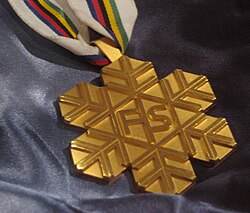History
The first Nordic Skiing World Championships were held in Chamonix in 1924, as part of the first Winter Olympics, which were only later recognized as such. [1] [2] The competitions took place annually until 1939. From 1925 to 1927, the FIS referred to the events as Rendezvous races, while in the years after that until 1935 they were held as FIS races. Since 1937, the competitions have had the official title of FIS Nordic World Ski Championships. Until the 1980 Winter Olympics, the Olympic champions were also World champions.
The 1940 Nordic World Ski Championships were canceled due to the war, but this was also criticized at the time. The Italian winter sports resort of Cortina d'Ampezzo organized the 1941 Nordic World Ski Championships. However, the FIS subsequently declared these invalid at a congress in Pau in 1946, so that the medals awarded lost their official status and were no longer counted. [3]
With the 1984 Winter Olympics, the rule that the Olympic winners were also World champions was finally abandoned. Since 1985, the Nordic World Ski Championships have taken place in odd-numbered years, independently of the Winter Olympics, in order to avoid an overlap with the Olympics.
The 1980 and 1984 World Championships consisted of a total of only three events; women's 20 km cross-country (1980), ski-jumping team event and Nordic combined team event (both 1984). These events were not held in the 1980 Winter Olympics and 1984 Winter Olympics and therefore got their own World Championships.
Historical notes
The following list shows when new events were added for the first time:
- 1933, men's relay (cross-country) was added.
- 1954, women's 10 km and 3 × 5 km relay was added, men's 15 km (cross-country) replaced the 18 km.
- 1962, men's normal hill (ski jumping) and women's 5 km (cross-country) were added.
- 1978, women's 20 km (cross-country) was added.
- 1982, men's ski jumping team large hill and Nordic combined team large hill were added.
- 1989, women's 15 km was added (cross-country) and women's 30 km replaced the 20 km.
- 1991, men's 10 km (cross-country) was added.
- 1993, cross-country pursuit (both genders) were added.
- 2001, men's ski jumping team normal hill was added and cross-country sprint (both genders) replaced the 10 km (men) and the 5 km (women).
- 2003, women's 30 km and men's 50 km (cross-country) changed from interval start to mass start. Additionally, the Skiathlon format was introduced for pursuit races (previously separate races on the same day).
- 2005, cross-country team sprint (both genders) were added.
- 2009, women's normal hill (ski jumping) was added.
- 2011, Nordic combined team normal hill was added.
- 2013, mixed team (ski jumping) was added and team sprint large hill (Nordic combined) replaced the team large hill.
- 2019, women's team normal hill (ski jumping) was added.
- 2021, women's Nordic combined with women's large hill (ski jumping) were added.
- 2023, Nordic combined mixed team event replaced men's team sprint large hill.
- 2025, men's 10 km replaced the 15 km (interval start, cross-country), women's 50 km replaced the 30 km (mass-start, cross-country), men's and women's 4x7,5 km replaced the men's 4x10 km and the women's 4x5 km (relay, cross-country), men's and women's 20 km replaced the men's 30 km and the women's 15 km (skiathlon, cross-country), men's compact 7,5 km replaced the Gundersen 10 km (normal hill, Nordic combined), women's mass-start 5 km + normal hill (Nordic combined) and men's and women's Para Sprint (separated from Para Cross-Country World Championships) were added. [4]
This page is based on this
Wikipedia article Text is available under the
CC BY-SA 4.0 license; additional terms may apply.
Images, videos and audio are available under their respective licenses.

